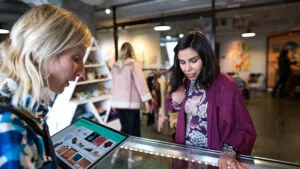
Keeping pace with mobile customers
Mobile commerce, once a novelty is now ubiquitous. Retailers seeking competitive advantages in mobile commerce today must identify and adapt to rapidly changing consumer behaviors and match their pace with innovations. Consumers once satisfied with simply searching and completing basic transactions on a mobile device, now demand personalized, rich and contextually relevant experiences. Retailers that don’t recognize these changes jeopardize their future.
If you are going to compete and win in mobile commerce today, you must target “markets of one.” It is no longer an effective strategy to treat your customers as one giant homogeneous market of unknown consumers. In today’s world of mobile commerce, where devices are intimate extensions of unique individuals, knowing those individuals as individuals, is key.
https://www.youtube.com/watch?v=i-RXJc4Z0XU&feature=youtu.be
Personalizing user experiences is not easy, as mobile consumers often use multiple devices and computers while shopping online. In fact, 56 percent of online shoppers regularly use multiple devices on a single path-to-purchase journey. That means personalization needs to be supported in all experiences and on all devices and platforms. Systems like Cognizant’s ONERetail, built on Microsoft’s Azure, have been designed to provide personalized analytics across all platforms based on an understanding of usage pattern, location and an understanding of context.
Our research has found different devices are preferred for different activities. Quick on-the-go search and discovery is often initiated on a smartphone, immersive research follows on a tablet, while transactions are finalized on a laptop. Using a combination of different devices, laptops and visits to brick and mortar stores makes it difficult for retailers to recognize a unique path-to-purchase customer journey. This is an obstacle that needs to be overcome by retailers. To add to the complexity, our research also found different devices are preferred at different times of the day. Smartphones are popular for online shopping in the morning during breakfast, at lunch and during commutes. Laptops and desktops are popular during working hours, while tablets are popular in the evenings.
In addition to all the previously mentioned complications, we found mobile consumers exhibit significant differences based on ages, education levels, genders, ethnicities and technology preferences (laptop/desktop vs. mobile). All of these variables equate to hundreds of thousands, if not millions of different combinations of needs, preferences, unique activities and behaviors. We call the unique set of variables which accurately describe a consumer “Mobile Me” (MME) profiles. Each unique MME profile requires different personalized content, at different times and locations, on different devices and platforms in order to provide an optimal experience. Our research reveals 90 percent of mobile users ages 18-34 highly value personalized mobile experiences. In order to deliver these experiences one must have real-time data collection, analytics, personalization engines and mobile applications capable of supporting real-time content personalization. One must also have an operational tempo within their IT systems and business processes capable of supporting real-time. These capabilities make possible innovative new business processes that provide significant competitive advantages for businesses that embrace them.
Delivering a real-time personalized experience, however, requires data and a lot of it. We have identified three key information rich sources of this data we call 3D-Me data sources:
- Digital – online activities, preferences, sentiment and profiles
- Physical – data collected from IoT sensors (on vehicles, buildings, equipment, wearables, smartphones, etc.)
- Personal – user preferences, roles, jobs, skills, locations, etc.
3D-Me data sources enable enterprises to collect the right data to gain an accurate understanding of real-time activities and insights into the needs of their customers. 3D-Me data source strategies require a new kind of partnership between customers and retailers we call MME (Mobile Me) Data Partnerships. In these partnerships, both parties agree to use a defined set of personal data in exchange for shared value. Customers receive rewards and special treatments, and retailers receive loyalty and more business. Personalized user experiences, however, are not enough. Consumers want contextually relevant personalization. Personalization becomes contextually relevant when you add time, location and activity patterns to the mix. Sending an SMS about discounts on diapers to an empty nester, even if historically it was a favorite brand, is simply not relevant at this moment. Relevant personalization requires the use of data triggers that identify contextually relevant opportunities, moments and environments (CROME). CROME triggers are bits of data that provide context, which can be used to provide relevant personalization at a specific time and place. These CROME triggers provide data that when analyzed, understood and integrated with relevant personalization engines, can optimize the user’s experience.
In today’s hyper-competitive mobile commerce environment, the winners of today and tomorrow are companies that understand the deep level of intimacy consumers have with their mobile devices, their desire for recognition and personalization, demonstrated appreciation for the value of personal data and can provide contextually relevant user experiences. Read more on how to deliver these strategies in my new report, Cutting Through Chaos in the Age of Mobile Me.
Kevin Benedict is a Senior Analyst with Cognizant’s Center for the Future of Work, and a popular technology pundit, writer and keynote speaker with over 30 years of experience. He brings a unique perspective as a veteran mobile industry executive who has taught IT and business strategy workshops in 17 different countries over the past three years.
Kevin Benedict’s Blog | LinkedIn | Twitter: @krbenedict





